#rockhounding
Text
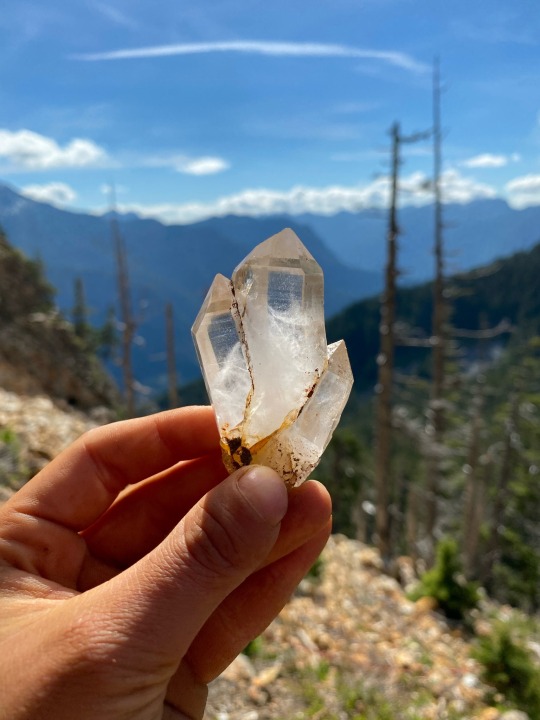
Mining magic in the mountains!
#minerals#crystals#quartz#mining#geology#gemsandminerals#crystal gems#rocksandminerals#pretty rocks#mountians#hiking#gemstone#uncut gems#specimen#washington#rockhounding#rockhound#backpacking#cool rocks#mineralogy#forest#earth science#rocks#mountains
712 notes
·
View notes
Text



Green Tube Agate - Like a minecraft
#minecraft#agate#special collections#collectibles#crystal collection#gemstones#geology#rocks and minerals#achat#crystals#rockhound#rockhounding#cool rocks#gems#green aesthetic#stone aesthetic#geological formations#geology rocks#geolocation
123 notes
·
View notes
Text
Montana is a rockhounder's paradise, famous for its sapphire mines. Montana offers several notable locations for those interested in digging for gems and crystals. Here are some popular locations where you can try your luck unearthing your own gems: Read more here:
16 notes
·
View notes
Text



chrysocolla double sided cab i cut and polished tonight :)
14 notes
·
View notes
Text


Carborundum log at sylverra
Link above | $5 flat shipping all US orders | Free US shipping over $50
#carborundum#minerals#mineral specimens#rockhound#rockhounding#rock hound#rock hounding#black crystals#rough crystals#rough minerals#iridescent crystals#iridescent#crystal shop#minerals for sale#shop small
65 notes
·
View notes
Photo
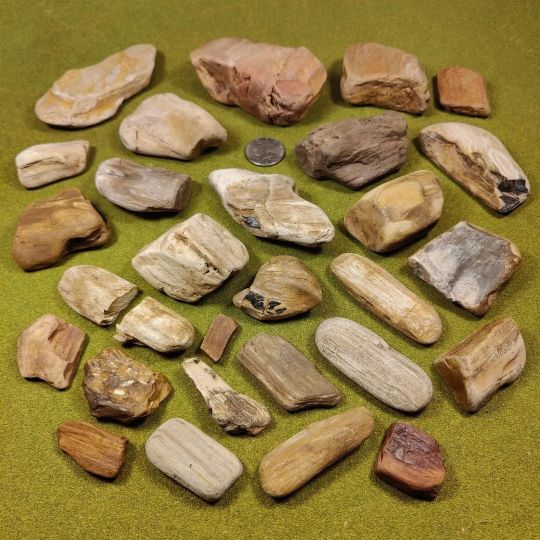
Petrified wood from the Willamette River, same trip as last post. Some excellent grain and optimistic agate cores in this bunch. I've already sliced up one of these pieces, and it's sick #rock #rocks #silica #rockhounding #oregon #rockhound #geology #agate #agates #quartz #crystal #zeolites #mineral #minerals #collection #earth #geo #nature #pnw #pacificnorthwest #mining #digging #wood #petrifiedwood #fossil #fossils #fossilwood #woodgrain (at Bar Mavin) https://www.instagram.com/p/Cl0DGp0uKO6/?igshid=NGJjMDIxMWI=
#rock#rocks#silica#rockhounding#oregon#rockhound#geology#agate#agates#quartz#crystal#zeolites#mineral#minerals#collection#earth#geo#nature#pnw#pacificnorthwest#mining#digging#wood#petrifiedwood#fossil#fossils#fossilwood#woodgrain
106 notes
·
View notes
Text

Went out to look for fossils again today, and I'd like to highlight these crinoids in matrix.
49 notes
·
View notes
Text

🎶 tryna keep ‘em round & shiny 🎶
#rockhounding#rock hounding#rocks#minerals#stones#gems#lortone#ridin’#they see me rollin’#illustration#lapidary#rock tumbler#artists on tumblr
15 notes
·
View notes
Text





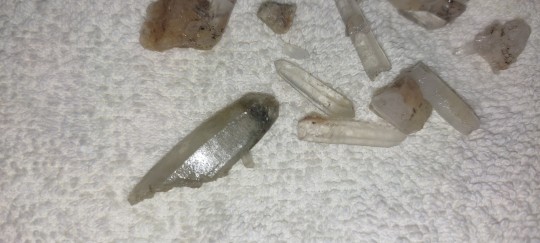

Lucky day near an abandoned mine.
After being cleaned in oxalic acid in order to remove rust
15 notes
·
View notes
Text

In Najran province of Saudi Arabia, carved in sandstone at the peak of a 200-meter hill facing east, is a petroglyph of a female figure. A petroglyph of a Mother Goddess that when lit by the rising sun, can be seen for miles on end. Over 4,000 miles north from Najran province, on Salisbury Plains in Wiltshire, England, one can find the world-famous Stonehenge— a circle of megaliths thought to be everything from an astronomical clock to a place of healing. Rocks and minerals are all around us, a part of common, everyday life and for time immemorial, our ancestors have prescribed them significant meaning. Since picking up rockhounding during the Pandemic as a way to get outside and still practice social distancing, I’ve become more and more interested in rock folklore which each excursion I take into some defunct mine or rock outcropping. As an artist and life-long folklore and mythology enthusiast, I’ve noticed that when it comes to nature lore, people are, in general, more interested in the lore surrounding things like trees and flowers. While I do love plant lore, the past year or so has seen me diving into the myths associated with rocks, mines and caves. I knew I needed a space to prattle on about my deep-dives, and thus the idea to write this little article was born!
First and foremost, I have to talk about the vittror (plural form of the singular vittra) a type of vættr, or nature spirit, found throughout Scandinavian folklore. I love the stories of the vættr, one of my favorite aspects of the stories being that the vittror can be found living in rocks and trees, and have the ability to harm humans who trespass into their domain. A vittersten is the name given to a boulder or rock formation that a vittra has claimed as their home. All vittror live along leylines called vittervägar, and it’s said that at the points where these leylines intersect, the veil is thinner. Supernatural happenings are more likely to occur in these spots, as well as accidents, illnesses and even death. A vittersten may lie at the intersection of one of these supernatural crossroads, and if you find yourself at such a dubious place, well… you’d best be careful. If you disturb a rock or a tree that a vittra calls home, you may find yourself with a newly-fabricated curse placed upon your person. If you find that you feel a sudden wave of nausea, a chill, or any kind of discomfort, it means you have disturbed a vittra. The best way to remedy this is to apologize to the vittra that you have offended, or leave offerings. There are stories of entire construction projects being re-routed or stopped altogether because the development of that area upset the particular vittra living there. So be careful, because you may find yourself on a hike with the need to relieve yourself behind a rock formation for some privacy… perhaps you are accidentally befouling the site a vittersten!
Another one of the more fascinating stones that have a particular folklore attached to them is the adder stone. The adder stone is a small rock with a naturally occurring hole bored completely through the center. Adder stones have a glassy quality and are usually flint, though in ancient times they were thought to be created from snake saliva, hence their name. Pliny the Elder wrote that adder stones were important to druids, and even until recent times, the adder stone has held a great importance in the British Isles. In England, they’re called Hag Stones, and in Scotland, Mare-Stanes, because it was said that whoever possessed one of these supernatural stones was immune to visits from the Mare or Hag, a vicious being that was said to sit on its victims’ chests while they sleep, causing them to have nightmares. In Scotland, Mare-Stanes were often kept near beds to prevent such night terrors, but they would also be kept on an individual’s person. They had other uses, too, such as being tied up in barns to ensure that a pregnant cow births her calf safely. One interesting story is that of a particular Mare-Stane with two human teeth affixed in the center hole of the stone, bequeathed to a villager of Marykirk, Scotland by an old woman who used the stone as a nightmare deterrent for some 70 years.
If we take a step back from the folklore surrounding individual rocks, and into the place where rocks are taken from the earth, you’ll find that mines of all varieties have a plethora of legend and lore associated with them. Being from California, I have heard many a tale of haunted mines and ghostly prospectors. I have visited the outskirts of the now decommissioned Emma Mine in Acton, California (about 50 miles north of Downtown Los Angeles) and have become intrigued by stories of old and forlorn mines. My interest especially piqued a few months ago when I read a passage from a 1959 article titled Tales of the Supernatural by J. H. Adamson for the Western Folklore journal. There was a passage about a mining site in Utah in particular that caught my eye:
“In another instance, a place was discovered to be demonic, not because of ghostly inhabitants, but rather because of a vein of ore possessed the strange property of drawing all the strength out of the bodies of those who approached it, leaving them weak, helpless and unable to stand.”
Something I discovered during my research I had no idea was a thing (for lack of a better word), was the amount of religious shrines built at mines, mostly to mother goddess and earth goddess figures. This concept of miners descending into the earth’s womb to retrieve precious materials as a highly spiritual and sacred practice makes a lot of sense in hindsight when I thought more about it. In fact, The Egyptian word bi not only translates to mineshaft, but to uterus as well. This was a practice wide-spread throughout the ancient world. At an archeological site known as Wadi el-Hudi in Southern Egypt, there is an amethyst mine that dates back all the way to the Middle Kingdom, over 5,000 years ago from today. Stelaes have been found at Wadi el-Hudi that describe a temple to Hathor that was erected at the ancient mine, where the goddess was evoked to watch over those mining, working, and traveling in the desert. The stela calls her The Lady Of Amethyst, with one inscription stating:
“Give Offerings! Give offerings to the mistress of heaven! Pacify Hathor! If you do this, it will be useful for you, if you give more it will be profitable among you.”
Even in the modern era, shrines have been erected at mining sites. One can find shrines to the Virgin Mary at mines across North America, South America, Europe and South Africa. As recently as the 1980s, a 90-foot statue of the Virgin Mary known as “Our Lady of the Rockies” was built on the Continental Divide 3,000 miles above the mining city of Butte, Montana.
I mentioned earlier in this article that as a Califonian, I’ve heard many ghostly mining stories throughout my life. While we have a plethora of stories, like that of old Joe Simpson and the ghost town of Skidoo, one of my favorite haunted mine stories actually comes from North Carolina. Gold Hill Mines, just outside of Charlotte, is associated with a slew of stories about haunted mines and ghostly prospectors. One of the more ghastly stories is that of an unfortunate miner who possessed some poor judgment— and dynamite— that blew himself up— whether on accident or on purpose, no one knows for certain. Local legend states that you can still hear the phantom explosion, and see otherworldly body parts violently disperse in the air, and then mysteriously disappear. I’m not sure if such a miner actually existed or if this is all local folklore, but it makes for a horrifying —and morbidly fantastic— ghost story.
I do, however, very much want to include a local story. This local story is about a cursed cave. I’m no geologist, but I think it’s safe to say that caves are rock-adjacent. The Cave of Munits is a popular hiking and rock climbing spot in the western San Fernando Valley here in Los Angeles county, but not many people know the legend associated with it. Located 86 miles from the stunning Chumash cave paintings near Santa Barbara, the legend surrounding the Cave of Munits is a tale that has both Chumash and Tongva origins. Munits was a sorcerer that kidnapped and killed the beloved son of a powerful chief. Munits stole the boy away to his cave, while the boy’s tribe stood below the cliff and demanded that the sorcerer return their chief’s son to him. Munits, however, cried “You want your boy back? Well, here he is!” And tossed the chief’s son out of the cave, limb by limb. The powerful chief ordered the death of the sorcerer Munits, sending a hawk to viscerally tear open Munits’ distended stomach as he lay sleeping after gorging himself full on clovers. It is said that the bile that flowed from Munits’ stomach is the origin of bitter clover.
While there are many storied tales and established legends about rocks, mines, and caves, there also exist many amazing stories that regular, everyday people have to tell— myself included. When I shared the bit of lore about the “demonic” ore vein in Utah online, many people shared their own strange rock stories, which prompted me to reconsider some of my own. I’ve had some strange experiences rockhounding, including a strange, deeply emotional experience while rockhounding out in the desert at a site called Gem Hill that is very difficult to put into words. I’ve also found a Mylar balloon at my aforementioned trip to Emma Mine. The Mylar balloon thing is… another story all of its own, but the tl;dr version is that Mylar balloons are frequently associated with the paranormal, especially cryptids, and the area surrounding Emma Mine has reports of everything from Bigfoot to Dogmen.
This article may be coming to an end, but my personal research is far from over. I feel like the folklore and mythology of rocks is often overlooked and forgotten— which is a shame, in so many ways. From prehistoric megaliths, to ancient mining shrines, to the modern day resurgence of adder stones, rock lore has been with us from the very beginning. I hope that in the very least, I’ve piqued your interest… and hopefully cause you to have more than just a passing thought about the next rock you pick up off the ground!
Sources
Adamson, J. H. “Tales of the supernatural.” Western Folklore, vol. 18, no. 2, Apr. 1959, pp. 81–82, https://doi.org/10.2307/1496463.
The Ancient Southwest | Angeline Duran. “The Cave of Munits.” THE ANCIENT SOUTHWEST, 5 Aug. 2020, theancientsouthwest.com/2020/08/03/the-cave-of-munits/.
Earl of Ducie. “Exhibition of three ‘Mare-stanes,’ or ‘hag-stones.’” The Journal of the Anthropological Institute of Great Britain and Ireland, vol. 17, 1888, p. 134, https://doi.org/10.2307/2841595.
Espinel, Andrés D. “A newly identified stela from Wadi el-Hudi (Cairo JE 86119).” The Journal of Egyptian Archaeology, vol. 91, no. 1, Dec. 2005, pp. 55–70, https://doi.org/10.1177/030751330509100104.
Goad, Mattie, and Eli Smith. “Conversations With Eli .” 6 Mar. 2019.
Jarvis, Robin. “The Old Mining Town in Gold Hill, North Carolina, Is Allegedly Haunted with Greedy Ghosts.” OnlyInYourState®, 13 Jan. 2018, www.onlyinyourstate.com/north-carolina/historic-gold-hill-nc/.
Johnson, John R. “The Indians of Mission San Fernando.” Southern California Quarterly, vol. 79, no. 3, Oct. 1997, pp. 249–290, https://doi.org/10.2307/41172612.
Judah, Hettie. Lapidarium: The Secret Lives of Stones. Penguin Books, an Imprint of Penguin Random House LLC, 2023.
Khan, Majeed. “The Rock Art of Saudi Arabia.” Bradshaw Foundation, Bradshaw Foundation, bradshawfoundation.com/middle_east/saudi_arabia_rock_art/index.php. Accessed 19 Aug. 2022.
Roud, Steve. The Penguin Guide to the Superstitions of Britain and Ireland. Penguin Books, 2006.
16 notes
·
View notes
Text
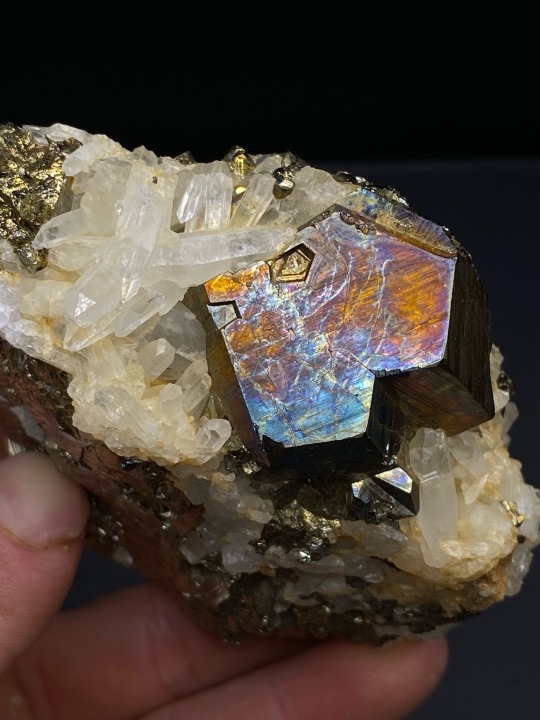
Lovely iridescent pyrite from the Spruce Ridge Mine, King County, WA, USA. Mined in 2022.
#crystals#mineralogy#minerals#quartz#pyrite#iridesence#natural#nature#beautiful#beauty#rocks#cool rocks#rocksandminerals#mining#mountains#forest#hiking#quartz crystal#rockhound#rockhounding#rocks rock
62 notes
·
View notes
Note
I've been trying to identify some of the stones I've been using to make knives maybe you could help me out
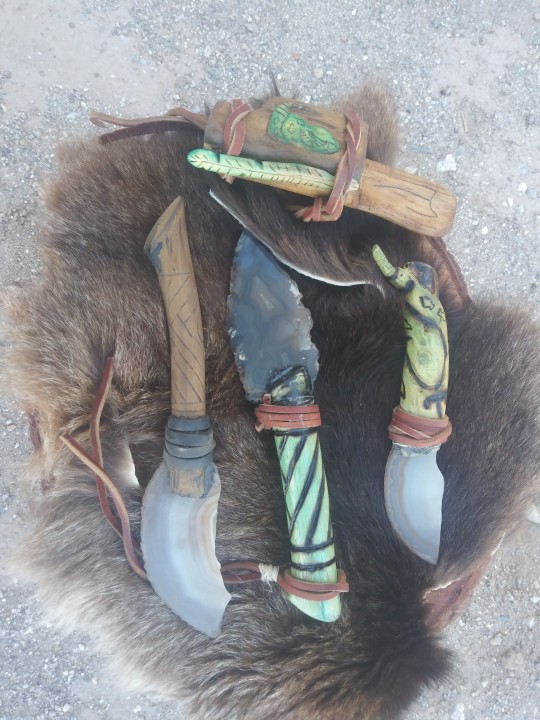


I'm far from being a geologist, (more of a Rockhound) but if I had to guess I would say that the majority of your material looks like Brazilian agate. Your finished products look quite magnificent. Do you make them to sell or is it just a hobby?
#knifecollection#knifefanatics#knifemaking#rocksandminerals#geode#geodes#crystals#rocks#quartz#rockhounding#minerals#stone knife#stone knives#agates#agate#Brazilian agate#agate slabs#sliced agate#geology#geology rocks#mineral#gemstones#gem#gems#agate geode#agate geodes#native american artifacts#native american#agate decor#display piece
60 notes
·
View notes
Text
I am once again sorting my rocks by color, size, shape, pattern, hardness, and translucency
6 notes
·
View notes
Text
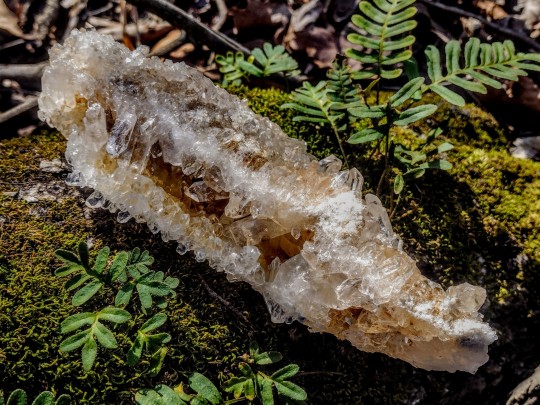

Large Quartz Cave Cluster - Avant Fisher Mountain Mine in Mt. Ida, Arkansas
Mined and prepared by ArkanStoneCrystals on Etsy
Take 10% off any order w/ promo code TUMBLR
#arkansas quartz#crystal clusters#optical clear points#display specimens#gems and minerals#healing stones#rockhounding
28 notes
·
View notes
Text
I was out collecting quartz crystals today with my mineralogy group, and the ground was a bit unstable and we were on a hill. I (a genius) decided to grab the nearest vine without looking at it first to steady me. The group leader looked at me and said “make sure to be careful of the poison ivy.” I (a person who very much knows what poison ivy looks like and had been extra careful not to go anywhere near it the whole time) responded, “no worries, I’m being very careful.”
My group leader: …
“… you’re holding it”
I let go of the poison ivy vine and immediately fell down the hill and bruised myself badly on a rock.
I did find cool rocks though so I consider today a win.
#rockhound#quartz#minerals#crystals#confidently incorrect#rockhounding#smooth brain moment#clumsy idiot#poison ivy
55 notes
·
View notes
Text


Clear quartz cluster at sylverra
Link above | $5 flat shipping all US orders | Free US shipping over $50
#clear quartz#quartz cluster#clear quartz cluster#crystal cluster#crystal clusters#geode#geodes#quartz geode#quartz geodes#rockhound#rockhounding#rock hounding#rock shops#rough crystals#rough quartz#minerals#mineral specimens
27 notes
·
View notes